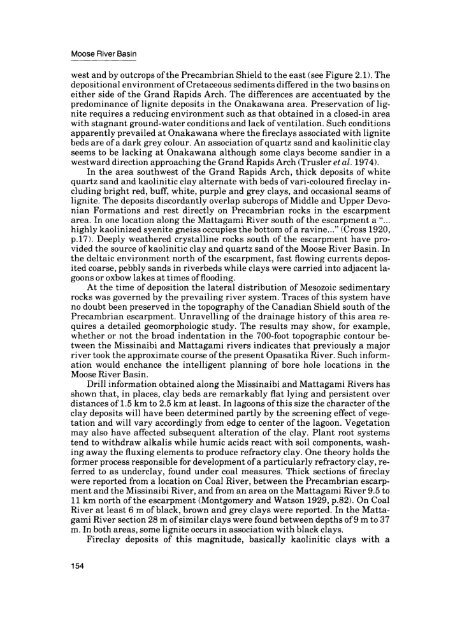Moose River Basin: geology and mineral potential - Geology Ontario
Moose River Basin: geology and mineral potential - Geology Ontario
Moose River Basin: geology and mineral potential - Geology Ontario
You also want an ePaper? Increase the reach of your titles
YUMPU automatically turns print PDFs into web optimized ePapers that Google loves.
<strong>Moose</strong> <strong>River</strong> <strong>Basin</strong><br />
west <strong>and</strong> by outcrops of the Precambrian Shield to the east (see Figure 2.1). The<br />
depositional environment of Cretaceous sediments differed in the two basins on<br />
either side of the Gr<strong>and</strong> Rapids Arch. The differences are accentuated by the<br />
predominance of lignite deposits in the Onakawana area. Preservation of lig<br />
nite requires a reducing environment such as that obtained in a closed-in area<br />
with stagnant ground-water conditions <strong>and</strong> lack of ventilation. Such conditions<br />
apparently prevailed at Onakawana where the fireclays associated with lignite<br />
beds are of a dark grey colour. An association of quartz s<strong>and</strong> <strong>and</strong> kaolinitic clay<br />
seems to be lacking at Onakawana although some clays become s<strong>and</strong>ier in a<br />
westward direction approaching the Gr<strong>and</strong> Rapids Arch (Trusler et al. 1974).<br />
In the area southwest of the Gr<strong>and</strong> Rapids Arch, thick deposits of white<br />
quartz s<strong>and</strong> <strong>and</strong> kaolinitic clay alternate with beds of vari-coloured fireclay in<br />
cluding bright red, buff, white, purple <strong>and</strong> grey clays, <strong>and</strong> occasional seams of<br />
lignite. The deposits discordantly overlap subcrops of Middle <strong>and</strong> Upper Devo<br />
nian Formations <strong>and</strong> rest directly on Precambrian rocks in the escarpment<br />
area. In one location along the Mattagami <strong>River</strong> south of the escarpment a "...<br />
highly kaolinized syenite gneiss occupies the bottom of a ravine..." (Cross 1920,<br />
p.17). Deeply weathered crystalline rocks south of the escarpment have pro<br />
vided the source of kaolinitic clay <strong>and</strong> quartz s<strong>and</strong> of the <strong>Moose</strong> <strong>River</strong> <strong>Basin</strong>. In<br />
the deltaic environment north of the escarpment, fast flowing currents depos<br />
ited coarse, pebbly s<strong>and</strong>s in riverbeds while clays were carried into adjacent la<br />
goons or oxbow lakes at times of flooding.<br />
At the time of deposition the lateral distribution of Mesozoic sedimentary<br />
rocks was governed by the prevailing river system. Traces of this system have<br />
no doubt been preserved in the topography of the Canadian Shield south of the<br />
Precambrian escarpment. Unravelling of the drainage history of this area re<br />
quires a detailed geomorphologic study. The results may show, for example,<br />
whether or not the broad indentation in the 700-foot topographic contour be<br />
tween the Missinaibi <strong>and</strong> Mattagami rivers indicates that previously a major<br />
river took the approximate course of the present Opasatika <strong>River</strong>. Such inform<br />
ation would enchance the intelligent planning of bore hole locations in the<br />
<strong>Moose</strong> <strong>River</strong> <strong>Basin</strong>.<br />
Drill information obtained along the Missinaibi <strong>and</strong> Mattagami <strong>River</strong>s has<br />
shown that, in places, clay beds are remarkably flat lying <strong>and</strong> persistent over<br />
distances of 1.5 km to 2.5 km at least. In lagoons of this size the character of the<br />
clay deposits will have been determined partly by the screening effect of vege<br />
tation <strong>and</strong> will vary accordingly from edge to center of the lagoon. Vegetation<br />
may also have affected subsequent alteration of the clay. Plant root systems<br />
tend to withdraw alkalis while humic acids react with soil components, wash<br />
ing away the fluxing elements to produce refractory clay. One theory holds the<br />
former process responsible for development of a particularly refractory clay, re<br />
ferred to as underclay, found under coal measures. Thick sections of fireclay<br />
were reported from a location on Coal <strong>River</strong>, between the Precambrian escarp<br />
ment <strong>and</strong> the Missinaibi <strong>River</strong>, <strong>and</strong> from an area on the Mattagami <strong>River</strong> 9.5 to<br />
11 km north of the escarpment (Montgomery <strong>and</strong> Watson 1929, p.82). On Coal<br />
<strong>River</strong> at least 6 m of black, brown <strong>and</strong> grey clays were reported. In the Matta<br />
gami <strong>River</strong> section 28 m of similar clays were found between depths of 9 m to 37<br />
m. In both areas, some lignite occurs in association with black clays.<br />
Fireclay deposits of this magnitude, basically kaolinitic clays with a<br />
154

















